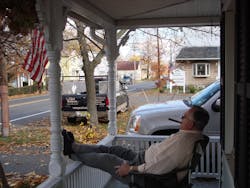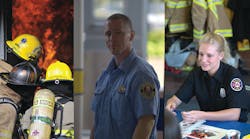My task with you today is work hard in order to make a fairly boring concept to life for you in such a manner that you will go running out the door of your office shouting at the top of your lungs "I have seen the future and it is great!" That is how I would like to present resource conservation to you. I see it as the key to fire department success as we wander through the 21st century.
When most people hear the term “resources conservation” they think of saving trees for future generation, providing clean drinking water and a host of similar natural resources conservation scenarios. In this article I am going to propose to you that the fire department of this century can only be successful if its members choose to carefully nurture the human resources which they have received from their citizenry.
Since change is inevitable, how well any fire department succeeds in future endeavors is based largely upon how well it prepares for them now. That is why it is essential to plant the seeds of organizational change now, so that they will have time to germinate, grow and mature.
Four resource areas can be subjected to a conscious conservation effort. They are:
- Conservation of effort: How much of a fire department is really necessary?
- Conservation of people: Protecting the most valuable resource.
- Conservation of dollars: Using each one wisely.
- Conservation of equipment: Overcoming the curse of the low bid!
Conservation of Effort
There are fire departments which have far too much in the way of firefighting resources for the type and size of community to protect. In its own way, this is as much a problem as those communities which habitually seem to be undermanned, underfunded and under equipped. Neither provides its community a proper return on dollars for public fire protection.
It is our contention that community fire protection can be tailored to fit the town, in much the same way that an English gentleman would have a suit clothes tailored to his frame. A fine thought, but how would it be done? Through a community fire risk survey. Great pains are taken to break a jurisdiction down into easily studied parts. This is easier than attempting to swallow a whole community in one analytical bite. I will cover this in a future visit with you.
By targeting the most severe hazards in a community, a relative level of risk can be determined. A study of fire suppression and protection resources allows for a level of community fire protection to be developed. Once an administrator knows what exists in terms of risk and protective capability, a program can be developed to address the identified problems. It is through this process that a level of community fire protection can be achieved which closely approximates the actual need which was identified. It is this analytical mechanism which will be discussed in detail in future editions of this column.
Conservation of People
As the folks at the General Electric Co. were so fond of saying back in the 1950s, “People are our most important product.” If you stop to think about it, this gem of wisdom can set the tone for your successful organizational trip through the world of the 21st Century.
Let me suggest that the first step in any equation involving your people is to start by recruiting the best possible candidates for careers in the fire service. If the need exists you may have to establish training programs to assist people in qualifying for a career in the fire service. In the volunteer world this means that our recruiting efforts must target people who will fit into the puzzle that is our local fire department.
Many fire agencies in the United States have developed a form of feeder mechanism by using local community college systems to train people for careers in the fire service. Through the completion of a thorough curriculum in all areas necessary to meet the requirements of National Fire Protection Association (NFPA) Standard 1001, “Firefighter Professional Qualifications,” candidates receive the knowledge necessary to enter a fire department. Their physical skills can then be polished to fit the individual needs of the departments that eventually employ them. By setting high standards a better quality of recruit is brought into the system.
We must all work towards enhancing the image of the fire service. By making duty in the fire service something to be envied, the chances of luring brighter, better people to its ranks is improved.
Once high-quality people have chosen firefighting as a calling, be it in a career or volunteer status, provide them the best possible training to allow them to perform the wide range of tasks demanded of the fire service generalist. They must be utilized to the greatest extent possible. Stress the importance of specialized schools on topics such as hazardous materials, confined space rescue and emergency medical technician. Novice firefighters must be impressed with the fact that learning is a long-term endeavor. To allow firefighters a route of advancement into the ranks of tomorrow’s fire service officers, the importance of college-level knowledge must be stressed.
Training as a mechanism for resource conservation has long been overlooked by the fire service. The future will demand more of each individual choosing to serve as a firefighter. It also appears that the funding available to perform this essential public service will be in short supply. To maximize the value of each individual firefighter, each must be able to perform a wider range of tasks.
Physical fitness in another area of great importance to the future of the fire service. Resource conservation stresses the value of getting the most out of each component in an organization. What better way to get an improved return on its recruiting and training than for a fire department to stress physical fitness? Can a firefighter who is out of shape perform at the same level as one who takes part in some form of structured, supervised exercise program?
I want you to know that I am not performing as well I did nearly 50 years ago when I entered the fire service. This physical deterioration is normal. Each of us must recognize this and work to over it. In my case I long ago stopped performing any interior structural firefighting duties. I still drive but only because I continue to pass my firefighter physicals. I also swim three days a week at our local hospital's fitness center.
The emphasis on physical fitness must be strengthened. After we recruit, train and nurture the best possible people for our organizations we must keep them healthy and fit for the demands of their job. By building up a long-term commitment to fitness, it is my belief that our personnel will incur less time off duty for illness and be less susceptible to injury at a fire scene.
Several major fire departments have had physical fitness programs for years. While the results vary, one concept remains constant. The successful programs have top-down acceptance and interest. What good does it do for a fire administrator to adopt a number of “do as I say, but not as I do” regulations governing physical fitness. (Or any other program for that matter.) When the person in charge makes a firm commitment to be a part of the physical fitness solution the impact on all members is quite positive. We did this here in Adelphia, N.J.. We have a well-equipped fitness center and a regular number of members who work out there.
What good comes from having a well-trained fire department if its members are constantly being bombarded by lost time due to injuries? Because of this, safety is an area which must grow importance if the effectiveness of fire department personnel is to be preserved and increased. Studies show that every area of fire department operations contributes to the overall injury rate.
People are being injured and, in some cases, killed, during training sessions, station maintenance and other areas which could easily be subjected to safety controls. Let me remind you that responding to emergency incidents kills and injuries as many people as actual fire combat. And the lack of a physical fitness program manifests itself on the fireground through exhaustion problems, heart attacks and simple strains and sprains. People who are not in good physical condition are also more subject to the stresses, both physical and mental, of active fire combat.
It is imperative for the following programs to be consulted by fire departments seeking to provide the highest possible level of safety:
- A safety program (NFPA 1500)
- A fire department safety officer (NFPA 1501)
- A safety committee (NFPA 1500)
- Mandatory self-contained breathing apparatus (SCBA) policies (NFPA 1500 and NFPA 1981)
- Appropriate live-fire training safeguards (NFPA 1403)
- A basic medical monitoring program (NFPA 1500)
- A defensive-driving program, such as the fine one developed by the National Safety Council.
- An accident review procedure developed by and for the department.
Take care of your personnel. They do not come cheaply. Let me assure you that any failure on your part to insure that these programs are created within your fire department might have strong negative consequences should someone be injured doing an act which should never have been done. Or it might be an act, action, or activity which was done by individuals within your fire department who take a devious pleasure in flouting the safe practices which are prescribed by your fire department. Here is where you need to lead by example.
You must not only create safe policies and procedures, but you must also train your troops in how to properly perform these procedures. In addition you too must operate within the confines of the safety policies which you have created or which are specified by your department. There is never any room for someone within your department to have a personal way of acting just because of their rank or position.
It is up to you to insure that all of your troops are allowed to return safely. To do any less is a violation of the trust that you have accepted as a leader within your fire department. Be diligent my friends because human nature tends to move in directions which end up being unsafe. Be safe not sorry.







